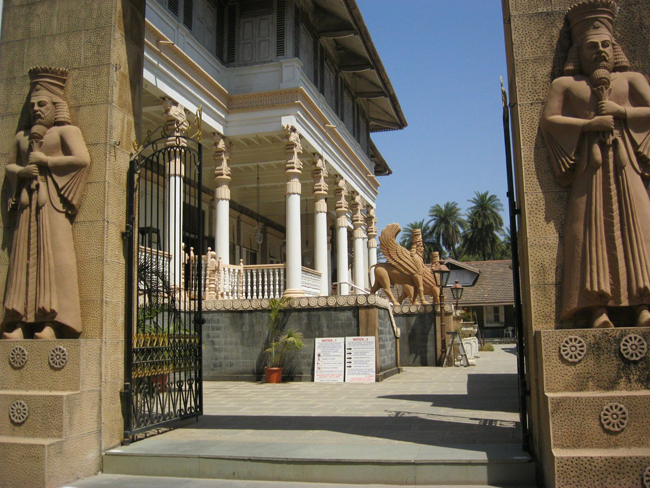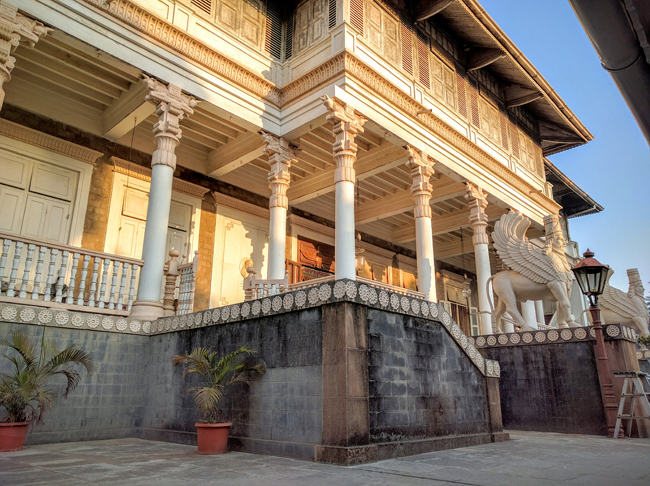Iranshah Fire Temple Gujarat - The Oldest Zoroastrian Religion Temple in India.
.jpg)
The Iranshah Fire Temple, also known as the Udwada Atash Behram is a sacred fire housed in a temple in Udvada, Gujarat on the west coast of India. It is the first of the eight fire temples of the Zoroastrian religion in the country. The Atash Bahram, meaning "Victorious Fire", is the oldest fire temple in India, dated to the eighth century, and represents the historical cultural and religious links with Iran. The temple structure, built spaciously, is well decorated and contains the Dasturji Kaiyoji Mirza hall and a museum. The main hall of the temple is accessed through a two-stage staircase. The temple attracts Zoroastrian pilgrims from all around the world.

The Atash Bahram fire was consecrated at Sanjan from alaat (sacred implements for consecration) brought from Iran to India in 715, consequent to the migration of Zoroastrians in Greater Persia due to the persecution by the Islamic rulers who conquered that country; those who moved to India are called Parsis; the earliest link of worship of the sacred fire in Zoroastrian temples are dated to the 4th-century BC. The Parsis traveled by ship from Hormuz in the Persian Gulf and landed on the Indian coast at Diu. They then moved along the coast to Sanjan, here the local Hindu king, Jadi Rana, gave them asylum and land to settle down but under a few stipulations. They settled down in Sanjan and then established their first Atash Bahram, a first-grade fire temple (fire drawn from sixteen sources) in India in 721 by enshrining the holy fire after consecration with alaats (sacred implements) that had been brought from Iran. This temple thus created a silsila, a traditional link, for the Parsi community of Sanjan with Iran. The consecration ceremony involved long and winding rites, which lasted for many months. The temple flourished, the community took firm roots, and it was their only such temple during that period, though as a community they spread to other regions of India. The Atash Behram (Iran Shah fire) is a symbolic representation of the Zoroastrian monarchy of Iran that was overthrown by Arabs.

The architect and builder of the temple was Dinshaw Dorabjee Mistry from Mumbai. The temple structure has been built spaciously and well decorated. The main hall of the temple, which is 50 by 25 feet (15.2 m × 7.6 m), is accessed through a two-stage staircase. The flooring in the hall is paved with Minton tiles. A portrait of the Zoroaster is fixed in the main hall at a vantage position. In the first floor, there is a very large hall of 100 by 50 feet (30 m × 15 m) size. The color scheme, the quality of carpets, and the type of tiles used in the temple have received appreciation from the devotees. The urwisgah, or place of the rituals for worship, is accessed from the doors on the right at the entrance. Within this temple, there are the Dasturji Koyaji Mirza hall and a museum. Portrait of important priests and the religious organizations, who have played a significant role in establishing the temple, are fixed on the outer hall walls of the temple. The original temple was refurbished by Lady Motlibhai Wadia in 1894.

The anniversary, known as salgiri, corresponding to the date of establishing the Atash Behram in Udvada and also in other Atash Bahrams in India, is celebrated every year according to the Shenshai Zoroastrian calendar. Apart from the salgiri, the other religious observance held every month is the "Bahram" day (the twentieth day of the month). The Parsi New Year, normally held in August, is also celebrated here when a large number of devotees flock to the shrine. On festive occasions, the Udvada shrine comes to life with large number of pilgrims engaged in buying sandalwood, flowers and other religious paraphernalia to offer to the fire. Newlywed couples also visit Udvada on pilgrimage, and on their behalf, their parents offer a machi (throne of wood to the fire) at the temple.

The fire temple of the Zoroastrian religion is located in Udvada village in Gujarat. Udvada is a small coastal village, of about 2 square kilometres (0.77 sq mi) area. The village was gifted to the priests by the king of Mandvi. It is approachable by road and rail. It is 206 kilometres (128 mi) away from Mumbai towards the north, situated between Vapi town and Daman on the National Highway (NH8) which passes through Manor. The nearest railway station is also in Udvada which is on the Virar-Surat section.
 EN
EN